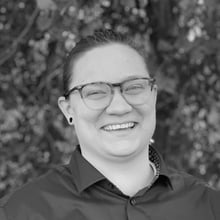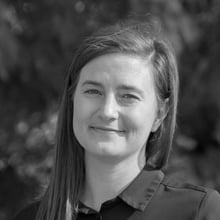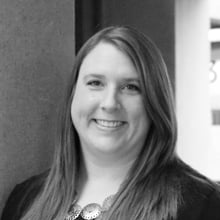Four transportation professionals share how their work impacts the communities they serve, the challenges they face, and how they respond to challenges.
Meet our transportation experts:

Mallory Bemis is a graduate traffic engineer who is passionate about creating safe ways for communities to move-about.

K. Lee Juelfs is a graduate highway design engineer who understands the importance of balancing complex roadway projects with public well-being.

Erin Jordan is a traffic engineer* who loves being part of transportation solutions that better communities and help create equality among residents.
*Registered professional engineer in IA, MN and WI.

Karen Kulesza is a highway design engineer* who enjoys the unlimited possibilities presented by transportation projects, from solutions developed by project teams to the impacts they have on their communities.
*Registered professional engineer in CO.
What about transportation engineering and the industry as a whole motivates you?
Mallory Bemis
What drives me is the opportunity to influence major components of the public’s daily lives, whether that be through commutes to and from work, biking around the city or a stroll through downtown. It’s extremely fulfilling to be part of a transportation design team at SEH that makes a project become reality.
K. Lee Juelfs
I enjoy knowing that my work provides communities with safer and improved routes to work, school and play. I can take pride in my work knowing it is part of an integrated whole that comes together to make these large projects a success. The work I do directly improves the lives of others in local communities. I enjoy visiting the project sites during construction, seeing plans come to life and, after construction, seeing the finished product with all of the separate parts working together.
Erin Jordan
The transportation industry impacts everyone – highways, bus routes, rural corridors, transit lines, aviation, bike trails and school crossings. You name it! As a traffic engineer, I plan and design solutions that I can actually go out and use in the real world. I am also motivated by the fact that transportation strategies can positively impact equity for people who are too often underserved. This includes providing safety improvements and connectivity for communities of color, low-income citizens and people with language barriers, improving economic viability and addressing public health concerns. I try to keep in mind that every little thing I do as an engineer is an opportunity to make a positive impact, and that’s pretty cool.
Karen Kulesza
I really enjoy the creative thinking required when designing transportation projects. Not one project I’ve worked on in the past five years has been the same. Although there are design criteria to follow with each project, there is quite a bit of flexibility when it comes to the final design of intersections and roadways. I feel satisfied when I successfully determine a creative solution to solve a difficult design problem!
Transportation engineers are always looking to develop innovative designs that may turn into the next “new normal” for everyday transportation needs. I am proud to work in the transportation industry, where creative and innovative thinking is always needed and highly encouraged.
How would you describe your role to a kindergartener?
Mallory Bemis
I would start by explaining the need for traffic control devices on the road. I would describe the use of pavement markings on the road to designate lanes, the necessity of signs to communicate with the drivers, and the use of stoplights to help drivers communicate with each other in order to cross busy intersections safely.
K. Lee Juelfs
I design and make the instructions for road construction. I work with many great engineers and scientists who determine where the roads and sidewalks will go, and what will happen to rainwater when it rains so that yards and parks don’t flood. We study the existing area to see what works and what needs to change to help the community, then as a team we decide what will work best. Once those decisions are made, the instructions or plans are used by road construction workers to build the roads, sidewalks and drainage systems.
Erin Jordan
My job involves helping everyone travel safely! I help determine the safest way for people to cross the street, how to reduce car crashes on the road and design traffic signals so people don’t have to wait too long at a traffic light.
Karen Kulesza
Whenever you leave your house, it is a transportation engineer’s job to make sure you can get where you want to go safely and quickly. As a transportation engineer, I draw the plans that show construction workers how to build the sidewalks and paths that you walk and ride your bike on, the roads your parents drive their car on, and the bus stops where you wait to ride the bus.
What about transportation engineering challenges you? How do you respond?
Mallory Bemis
Since I am at the beginning of my career, my job challenges me in new ways every day. I have been able to build a foundation designing several traffic components for a variety of projects under various professional engineers.
K. Lee Juelfs
Working with real-world problems is always challenging due to the consideration of unknowns, changing conditions and fitting all project needs into a set space. However, by using technology and teamwork, we can make these challenges attainable, while giving the community a quality project.
Erin Jordan
I am challenged in a variety of ways. I am challenged to think independently and creatively, in addition to balancing my clients’ goals and budgets. These two things can combat each other so it’s important to find the balance and engage stakeholders early and often to reach a conclusion that meets the goals and provides sustainability for the community. It can be most challenging when there isn’t a clear answer, and you have to be extra diligent in discussing the decision and deciding how to move forward as a team.
Karen Kulesza
Every project is unique, so it’s challenging to determine the best solutions that will solve issues specific to each project. Most of the time, there isn’t a single, cookie-cutter solution that you can apply to each project, and the preferred solution may differ depending on the client’s requirements. When designing projects, I rely heavily on my past experiences and my coworkers’ knowledge to make sound decisions in the client’s best interest.
How does your work impact the communities you serve?
Mallory Bemis
The traffic design work I complete most immediately impacts the communities I serve. I see how the senior engineers I am working with are creating safe commutes to and from work for drivers, bikers and pedestrians by the specific configuration and type of devices they install such as traffic signals and rectangular rapid flashing beacons.
K. Lee Juelfs
Building safe intersections and roadway segments have impacted communities by providing pedestrian and bicycle facilities where they are needed. Communities can thrive when all users have safe access to roads and sidewalks. When these facilities are designed with all users in mind, it helps people be more active in their day-to-day lives. Some of the safety measures we provide that impact communities include wider shoulders in rural areas; ensuring Americans with Disability Act standards are met for sidewalks and crosswalks in downtown areas; and adequate acceleration and deceleration lanes on highway interchanges.
Ensuring that roads and sidewalks are designed and built well results in healthier and happier communities.
Erin Jordan
Most of the traffic studies I work on ultimately end up as construction projects, and I really enjoy helping clients understand the “why” behind the project and the “how.” These projects range from improving signal timings to reducing severe crashes at an intersection or prioritizing pedestrians, redesigning the circulation in a school parking lot to improving traffic flow, or recommending crossing enhancements to supplement bike trails or school crossings.
All projects – large and small – can help achieve the goals of a community. I love having the opportunity to play a small part in helping these projects reach these goals.
Karen Kulesza
Transportation projects directly impact their community every day. The projects I have had the opportunity to work on improve the safety and functionality of intersections and roadways within various communities. Whether the project is to improve the safety of a rural highway, the capacity of a busy intersection or the provision of low-stress pedestrian and bicycle facilities, the communities and surrounding communities directly benefit.
It’s always exciting to see a project progress from the preliminary planning stages to full design and construction. It’s also exciting to see the positive reactions from the community.
Why did you choose SEH? What sets SEH apart in the industry?
Mallory Bemis
As I was approaching graduation and began my job search, SEH’s core purpose of Building a Better World for All of Us® really stood out to me. I chose SEH because of the opportunities it presented in my field and the variety of services we provide – ultimately having the opportunity to be an essential component of a diverse set of projects. Having experts in so many different specialties allows us to quickly tap into information from colleagues. I stay at SEH because I sincerely enjoy the people that I get to work with every day.
K. Lee Juelfs
I chose SEH because of the positive, empowering and innovative culture I witnessed during my interview, as well as the fact that SEH is 100% employee-owned. Employee-ownership has created a real sense of camaraderie among teammates. I’m also learning so many new skills while working at SEH. I attribute that to my awesome coworkers and the variety of projects I have been able to work on (and possibly the tour of the 3D printing/modeling room at the end of my interview).
Erin Jordan
In 2014, I worked with SEH in a different Twin Cities office as an intern on the municipal team, where I first connected with Heather Kienitz. However, school/life kept me in Madison, Wisconsin for the next nine years where I began my traffic engineering career. Being originally from the Twin Cities, I knew I always wanted to come back; it was just a matter of time. It was a bonus knowing that the Twin Cities offers a lot of great traffic engineering opportunities, especially for folks like me who love diving into multimodal projects.
I always knew SEH to have an excellent reputation – there are some fantastic, hardworking people that I’ve had the opportunity to work with and learn from. I believe SEH sets itself apart from other companies in the industry by being employee-owned, investing in the right people and technology and being able to produce exceptional work for our clients.
Karen Kulesza
I chose SEH because of the strong leadership, the welcoming culture and the exceptional benefits provided to employees. SEH employees take pride in our mission of Building a Better World for All of Us® – something I see evidence of daily.
Being an employee-owner at SEH encourages employees to take ownership in the success of the company as a whole, which I believe leads to high-quality projects for our clients. SEH continually encourages employees to implement innovative ideas, which I think sets us apart in the industry. SEH employees genuinely care about our communities and take every opportunity to help in the best, most effective way we can.
Interested in a career in transportation engineering?
Visit our careers page to connect with a recruiter to discuss open positions at SEH.

.png?width=113&name=SEH_Logo_RGB%20(1).png)
